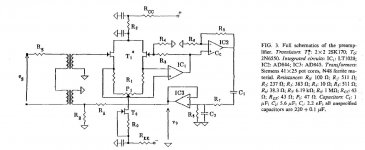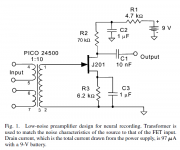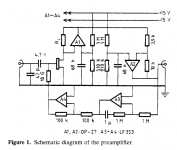I am using lead batteries all the time for my prototyps. Actually there is a lead type that can be charged more then 600 times and my preamp is playing 2 weeks on them without switching off. They are called pbq VRLA batteries. I use the 12V 7.0Ah type.
I decouple lockally with elcaps and foils and noise from that source is superbly low.
Nice to see that this persisting myth about terible noise from batteries get´s destroyed here.
I decouple lockally with elcaps and foils and noise from that source is superbly low.
Nice to see that this persisting myth about terible noise from batteries get´s destroyed here.
I wonder if it's possible to implement a cross correlator with an analog multiplier.
Wouldn't you rather do all the post processing in software?
Wouldn't you rather do all the post processing in software?
The log measurements have to be done, summed and reported out simultaneously. You've got volts squared on the output, just need bandwidth and you're good to go.
A bit old, but it does give an idea.
1995 IEEE INTERNATIONAL FREQUENCY CONTROL SYMPOSIUM. MEASUREMENT OF VOLTAGE NOISE IN CHEMICAL BATTERIES. Chadwick K. Boggs, Alan D. Doak, F. L. Walls
http://tf.nist.gov/general/pdf/1133.pdf
For those in a hurry, attached Figure 2.
I would definitely not like batteries in a phono stage for instance, but the idea doesn't bother me for a lab measurement preamp which is only occasionally used. In fact many instruments have a battery option as well, but can't be sure if it's for portability reasons or low noise (or both).
Ikoflexer I think batteries are used to remove the problem of earth loops.
Regards
Arthur
Hi Scott, I really think I should change the thread title to allow for more solution, since the discussion is interesting as is (to me at least).
I read that article a little while ago and even would my own transformer 😀 Here's the whole article for those interested:
http://www.picovolt.com/win/elec/articles/Lepaisant_preamp-xfmrs_RSI.pdf
But, and this is a big BUT. Number one problem for many people would probably be the transformer. I looked up the 41x25 pot core of N48 ferrite material, and it's not easy to find. I could find only Epcos making it, and they don't have a distributer in Canada. A few in the US, but haven't contacted any of them for a price. They get down to 5Hz with only 10 turns in the primary... Then they also mention that they had to machine the cores to increase the
As I said I wound up my own transformer on a high mu toroidal ferrite core but below 500-600Hz the frequency response was bad.
Also, if I was to use this to measure the noise of a voltage regulator with 15V DC on its output?
There's another neat little paper
http://web.njit.edu/~sahin/LowNoise2005.pdf
a simpler circuit using a microphone transformer. Several problems with that, including a max upper frequency somewhere between 40kHz and maybe 100kHz depending on how good the transformer is.
Edit: about the second paper, perhaps the idea of interest there is that of "noise matching" or matching the internal resistance of the signal source to that of the input jfet, which would be en/in. They use a J201 so they calculate en/in as
Rso = 6 nV/rtHz / 0.6fA/rtHz = 10Meg.
Then they calculate the optimum number of turns for the transformer as
n = sqrt (Rso / Rs)
where Rs is the internal resistance of the signal source.
In any case, the idea is that the closer the match, the lower the output noise of the amplifier will be, and the higher the SNR.
I read that article a little while ago and even would my own transformer 😀 Here's the whole article for those interested:
http://www.picovolt.com/win/elec/articles/Lepaisant_preamp-xfmrs_RSI.pdf
But, and this is a big BUT. Number one problem for many people would probably be the transformer. I looked up the 41x25 pot core of N48 ferrite material, and it's not easy to find. I could find only Epcos making it, and they don't have a distributer in Canada. A few in the US, but haven't contacted any of them for a price. They get down to 5Hz with only 10 turns in the primary... Then they also mention that they had to machine the cores to increase the
As I said I wound up my own transformer on a high mu toroidal ferrite core but below 500-600Hz the frequency response was bad.
Also, if I was to use this to measure the noise of a voltage regulator with 15V DC on its output?
There's another neat little paper
http://web.njit.edu/~sahin/LowNoise2005.pdf
a simpler circuit using a microphone transformer. Several problems with that, including a max upper frequency somewhere between 40kHz and maybe 100kHz depending on how good the transformer is.
Edit: about the second paper, perhaps the idea of interest there is that of "noise matching" or matching the internal resistance of the signal source to that of the input jfet, which would be en/in. They use a J201 so they calculate en/in as
Rso = 6 nV/rtHz / 0.6fA/rtHz = 10Meg.
Then they calculate the optimum number of turns for the transformer as
n = sqrt (Rso / Rs)
where Rs is the internal resistance of the signal source.
In any case, the idea is that the closer the match, the lower the output noise of the amplifier will be, and the higher the SNR.
Attachments
> I looked up the 41x25 pot core of N48 ferrite material, and it's not easy to find. I could find only Epcos making it ...
https://www.distrelec.de/ishopWebFront/xmlCatalog/node.do?groupId=EP-B65621J0250A048
Special order min 50 pcs.
360 Euros incl tax, so about 7 Euro a piece. Not cheap !!
If there is interest for 50 pcs, I can arrange the purchase.
Just the core, no winding.
But probably there should be a substitute.
Patrick
https://www.distrelec.de/ishopWebFront/xmlCatalog/node.do?groupId=EP-B65621J0250A048
Special order min 50 pcs.
360 Euros incl tax, so about 7 Euro a piece. Not cheap !!
If there is interest for 50 pcs, I can arrange the purchase.
Just the core, no winding.
But probably there should be a substitute.
Patrick
Then this topology might be recognizable 🙂
1989, A low-noise JFET preamplifier for capacitance bridges. Author. G W Small and K E Leslie. Affiliations. Nat. Meas. Lab., CSIRO Div. of Appl. Phys., J. Phys. E: Sci. Instrum. 22 (1989) 446449. Printed in the UK
I attached the schematic, who wants the article send me PM.
1989, A low-noise JFET preamplifier for capacitance bridges. Author. G W Small and K E Leslie. Affiliations. Nat. Meas. Lab., CSIRO Div. of Appl. Phys., J. Phys. E: Sci. Instrum. 22 (1989) 446449. Printed in the UK
I attached the schematic, who wants the article send me PM.
Attachments
> I looked up the 41x25 pot core of N48 ferrite material, and it's not easy to find. I could find only Epcos making it ...
https://www.distrelec.de/ishopWebFront/xmlCatalog/node.do?groupId=EP-B65621J0250A048
Special order min 50 pcs.
360 Euros incl tax, so about 7 Euro a piece. Not cheap !!
If there is interest for 50 pcs, I can arrange the purchase.
Just the core, no winding.
But probably there should be a substitute.
Patrick
Material #77 looks close to N48 on some important specs and there are several places that let you buy in 1's or 2's quantity. I'll see if our transformer models can deal with this beast.
Last edited:
Good idea Scott, another material close to N48 seems to be N22, with even less loss at lower frequencies, and found a place which sells 47x29.8mm pot cores for about $10 a pair. Same place has 47x40mm E cores material 77 at $5.5 a pair. All of a sudden this seems doable, if they ship to Canada.
Ferrite: E Cores
Patrick, thanks for the suggestion, but let's see if we can find something that could do the trick and cost a bit less.
Ferrite: E Cores
Patrick, thanks for the suggestion, but let's see if we can find something that could do the trick and cost a bit less.
No problem. 😉
Patrick
PS Scott, please don't forget the JFETs for noise measurements.
Patrick
PS Scott, please don't forget the JFETs for noise measurements.

Last edited:
Actually if someone could redesign, there are many choices for EPCOS N48 cores available as stock items (no MOQ), such as :
RM4, 5, 6, 8, 10
P22x13, 26x16, 30x19, 36x22
No problem getting those....
I suppose if we use 36x22, either the wire size has to go down (increase R), or no of turns have to be reduced (reduce L).
Patrick
http://www.epcos.com/web/generator/...F/PDF__N48,property=Data__en.pdf;/PDF_N48.pdf
http://www.epcos.com/web/generator/...ls=none_21none_21_20_21_20_21_20,print=1.html
https://www.distrelec.de/ishopWebFr...Phrase=&keywordPhrase=epcos+n48&vendorPhrase=
RM4, 5, 6, 8, 10
P22x13, 26x16, 30x19, 36x22
No problem getting those....
I suppose if we use 36x22, either the wire size has to go down (increase R), or no of turns have to be reduced (reduce L).
Patrick
http://www.epcos.com/web/generator/...F/PDF__N48,property=Data__en.pdf;/PDF_N48.pdf
http://www.epcos.com/web/generator/...ls=none_21none_21_20_21_20_21_20,print=1.html
https://www.distrelec.de/ishopWebFr...Phrase=&keywordPhrase=epcos+n48&vendorPhrase=
Last edited:
This does not qualify as simple, but still the lowest I can find (.065nV). The article has full disclosure of every detail so it could be duplicated.
Dear Scott,
Would you be kind enough to give us the details for the article of the circuit so that we can read it (author, journal, year, etc)? Thank you very much!
Best regards,
Satoru
Replace T0 (2N6550) by 2SK117 in post #126 ?
Patrick
Interfet is, indeed, hard to source.
I simmed it with my 2SK117 model -- it isn't going to be easy to tame. As the authors state, Rs is very important indeed. Would be nice to know what the starting values are for Ra and Rb.
Seems that the authors used a pair each k170 on the legs of the diff amp, or am I reading the article incorrectly?
Dear Scott,
Would you be kind enough to give us the details for the article of the circuit so that we can read it (author, journal, year, etc)? Thank you very much!
Best regards,
Satoru
Post 127 has a link to the article pdf.
Interfet is, indeed, hard to source.
I simmed it with my 2SK117 model -- it isn't going to be easy to tame. As the authors state, Rs is very important indeed. Would be nice to know what the starting values are for Ra and Rb.
Seems that the authors used a pair each k170 on the legs of the diff amp, or am I reading the article incorrectly?
T_0 (2n6550) is just a current sink. Why not use a k170v of two roughly matched k170bl in parallel?
Back to the input transformer. Might be really tricky to get decent low frequency performance from any ferrite transformer. So why not use the series transformers trick from RDH page 888 (attached)?
The idea is to wind two difference transformers, one for high frequency, say, on a ferrite core, and the other on a mu-metal core, or maybe even a core from a power transformer. Then connect them in series but use a high pass and a low pass filter to each handle the range that it's meant for it.
I wonder if something like this would work better than the specialized transformer from the article.
The idea is to wind two difference transformers, one for high frequency, say, on a ferrite core, and the other on a mu-metal core, or maybe even a core from a power transformer. Then connect them in series but use a high pass and a low pass filter to each handle the range that it's meant for it.
I wonder if something like this would work better than the specialized transformer from the article.
Attachments
- Home
- Amplifiers
- Solid State
- Simple 60dB discrete low noise amplifier (lna)



